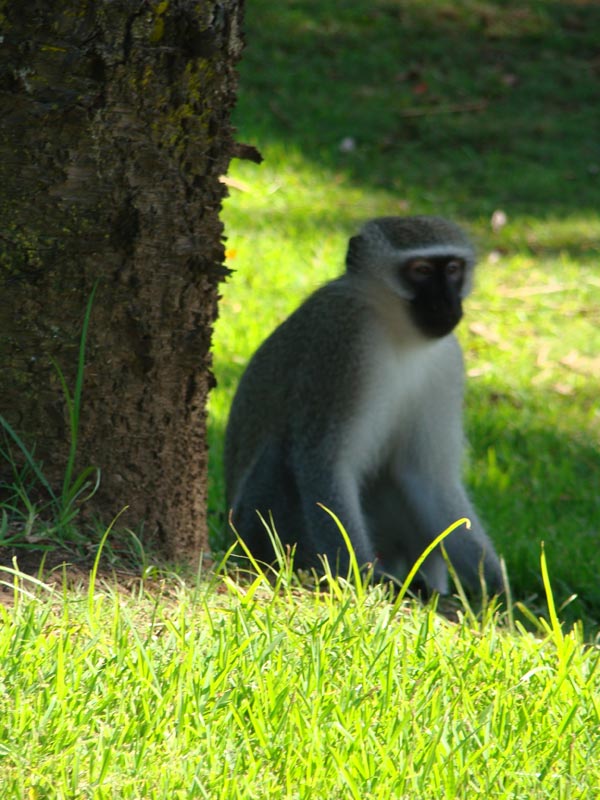Durban Country Club
Natal, South Africa
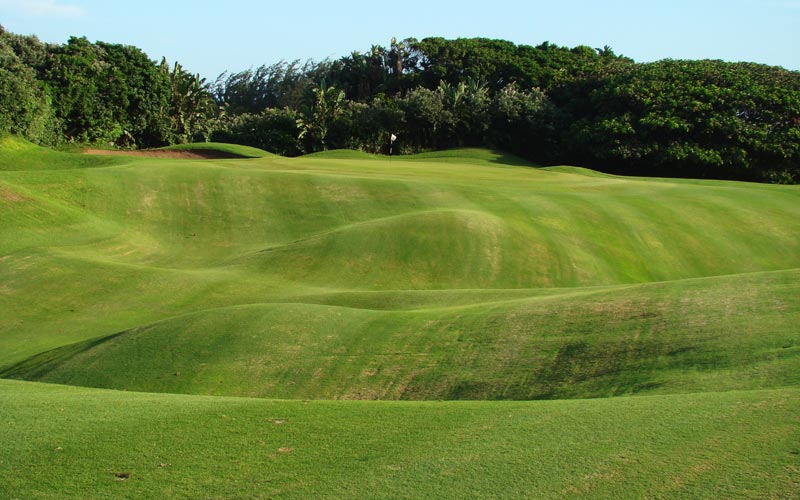
Some of the game’s most distinctive fairway contours have wooed golfers for decades to South Africa to play Durban Country Club.
There is no substitute for great property as Royal Durban found out to its dismay during the 1918 South African Open (which, by the way, is the second oldest Open in the world). Low-lying and flat, its course flooded during the heavy rains and the event became a slop fest. The city of Durban was South Africa’s second biggest at the time and the thought of never hosting the continent’s most prestigious event prompted several local businessmen to start Durban Country Club.
In stark contrast to the inland property at Royal Durban, they found a rectangular strip of land north of the city running parallel to the Indian Ocean. Better yet, a touch more than half the property featured wild, rambunctious sand dunes feeding in from the beach. Combined with its naturally sandy soil, the founding members knew that the drainage issues that plagued Royal Durban would not be a concern here.
To lay out the course, they turned to Laurie Waters and his assistant George Waterman. According to Ron Whitten in The Golf Course, the Scotsman Waters apprenticed under Old Tom Morris before immigrating to South Africa in the early 1900s. As a golf professional, he made a name for himself by winning four South African Opens prior to 1920 as well as having introduced grass greens to South Africa at Royal Johannesburg in 1910.
Opened for play in 1922, Waters’ work was deemed of such outstanding character that Durban Country Club hosted the South African Open shortly thereafter, its first of sixteen (!) times of doing so. To the club’s credit, it has always sought to retain its stature among the elite courses in the world and it welcomed proposed changes to the course by Major S.V. Hotchkin during his famous 1929 tour of the country.
From 1924 through 1935, Syd Brews was based out of Durban and always acknowledged that the testing coastal conditions played a major role in helping him to develop into a world class player. Just how good was he? In 1934, he finished runner-up in the Open and in 1935 won two out of the three tournaments in which he played in the United States. In addition, he won the French, Dutch and Belgian Opens the same year. Thus, it is fair to say that long before Gary Player, Brews put South Africa on the map as a major golfing power and both Durban Country Club and Brews mutually benefited from their relationship.
The holes fall into one of two categories: those that play in and out and over the dunes (holes 1-5, 8, 9, 12, 13, 17, 18) and those that are farther removed from the dunes and ocean. The remaining seven holes (6, 7, 10, 11, 14, 15, 16) play across flat land where the high to low point is less than seven feet. As has been stated often, the dunesland holes are full of allure given how distinctive the landforms are and how they were captured within the holes. Originally, the seven flatter holes held the golfer’s interest as they possessed the most interesting man-made features on the course. Based on an aerial from the 1930s that hangs in the stately clubhouse, the three-shot tenth featured a dramatic central hazard of the Hell’s Half Acre type. Two large bunkers down the left of the fourteenth gave that hole interesting playing angles and the one shot fifteenth was entirely surrounded by sand. The Golden Age architects appreciated that the flat holes would be a letdown without building such features. In addition, these mammoth bunkers helped to pull the sandy qualities of the dunesland holes across the rest of the property. In that manner, the transition from the dunesland holes to the flat holes and back was less jarring. Unfortunately, these sandy features have been removed and the flat holes now suffer from a lack of playing interest and the courses lacks a flowing quality as the golfer passes between the two type holes.
The club has been considering a Master Plan from David Kidd but progress is slow. The road map to restoring continuity to the course hangs on their clubhouse wall in the form of the 1930s aerial, and from it, grandeur could be restored. Nonetheless, as we see below, the dunesland holes as they exist today and the warm welcome that is guaranteed beckon the golfer to make the trip.
Holes to Note
First hole, 390 yards; The first five holes at Durban Country Club are considered among the game’s most taxing starts. With the exception of the fourth which turns and plays back in a southerly direction, these opening holes feature out of bounds right and coastal bush left. The playing corridors aren’t wide by the standard of most Golden Age courses. In fact, given the severity of trouble on either side, the elevated tees, and the ever present wind, just hitting the fairways – rather than selecting one side or the other – is challenge enough for most golfers.
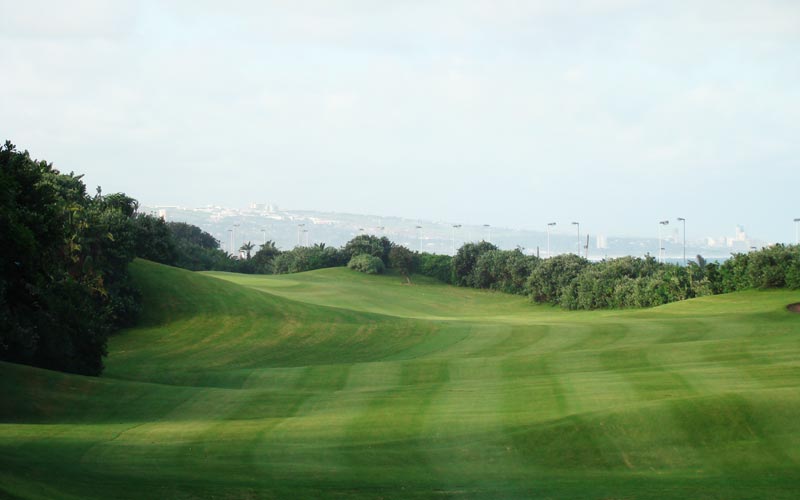
The appealing ripples found down the first fairway and how the hole swings left around a dune hint at the glories that are to come.

Almost all the best holes at Durban feature an approach shot to a green that sits atop a dune with the approach to the first being but one example.
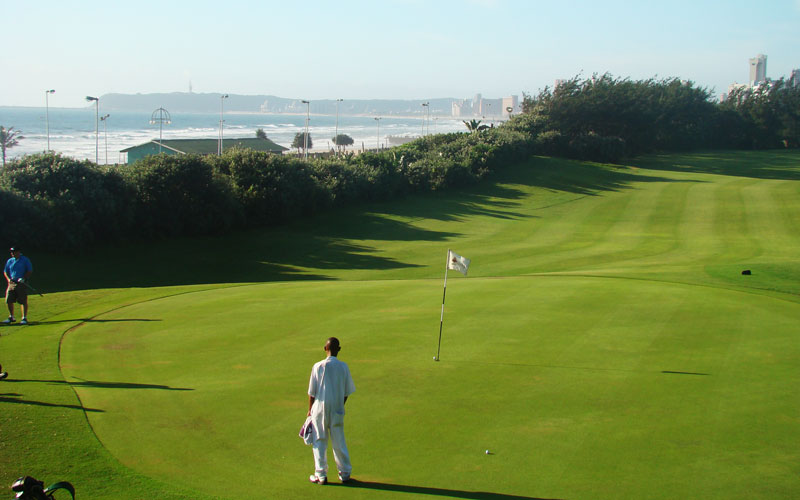
This view from behind the first green highlights just how close the course is to both the Indian Ocean and the freeway. The green is angled toward the outside of the dogleg and it’s a confident golfer who throws his approach shot out wide and lets it ride back in on the right to left wind off the ocean.
Second hole, 190 yards; Early in the round, the golfer is placed on the highest point on the course which is the second tee. Although he appreciates the long views of both the Indian Ocean to his right and the attractive hole before him, he is nonetheless totally exposed to the wind. When played in a cross wind, the second to its tightly defined target is an early barometer as to who the real players are in the group as they control the shape and flight of their ball. Syd Brews would have relished the chance to showcase his complete shot making skills at a hole like this.
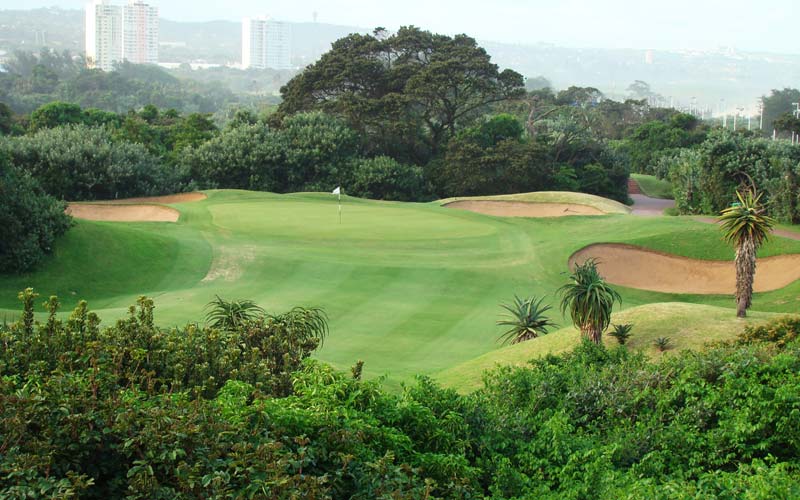
The feel of the second hole has greatly changed over the decades. Originally, the golfer was keenly aware that he was playing from the top of one dune to the top of another. Decades of bush and vegetation growth has altered that perception. The essence of the challenge remains the same though missed balls now can be much more harshly penalized.
Third hole, 515 yards; Pat Ward-Thomas did the continent of Africa an enormous service when he selected this hole for his eclectic eighteen, thus exposing generations of readers to the singular charms of Durban Country Club. An elevated tee is once again not necessarily the golfer’s friend on windy days, although the extended carry from the tee does help bring the green in reach in two. As seen from on high, the fairway takes on the appearance of a narrow ribbon winding its way past thick vegetation and large bunkers. In his hole description, Ward-Thomas wrote that ‘the drive is not the most difficult shot’ but this author begs to disagree.
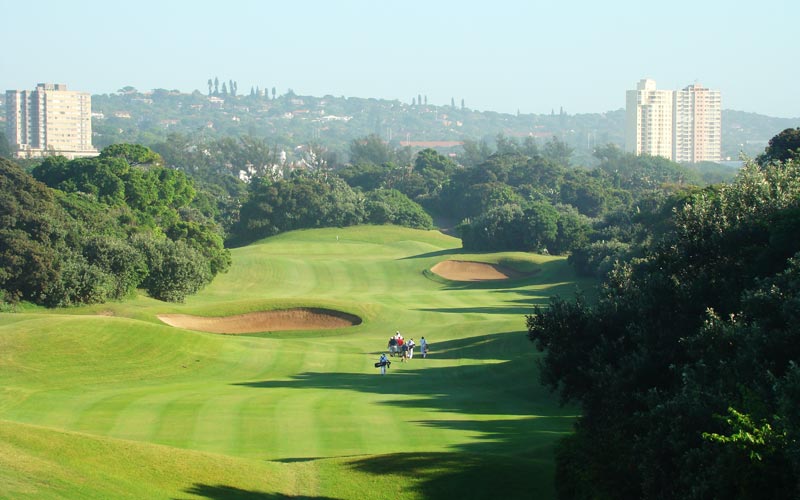
The elevated tee and vegetation crowding in makes the third fairway look narrower than it actually is.
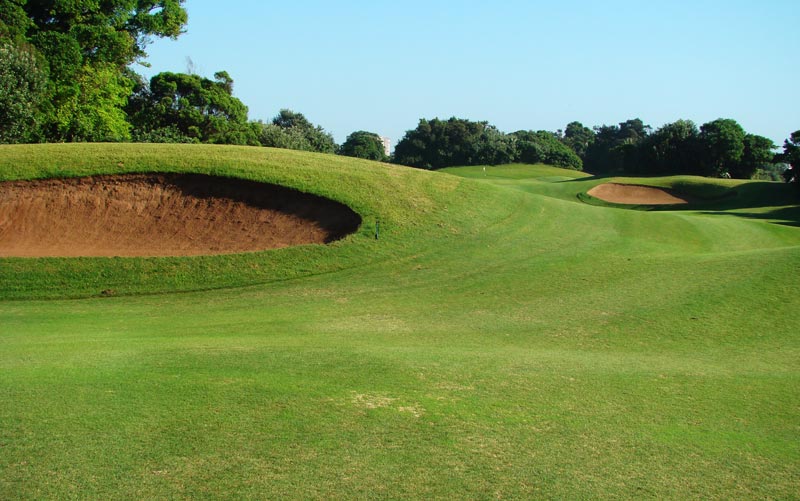
If the tee ball sneaks past this large bunker that was cut into a dune, the golfer has a chance of reaching the elevated green in two. Otherwise, the lay-up is a fairly straightforward affair played to the left of the large bunker seen farther ahead.
Fourth hole, 180 yards; A charming little hole, which istucked into a fold at the base of a dune. The sudden shift of playing more toward the ocean rather than parallel to it means the golfer needs to recalibrate the effects of the wind.
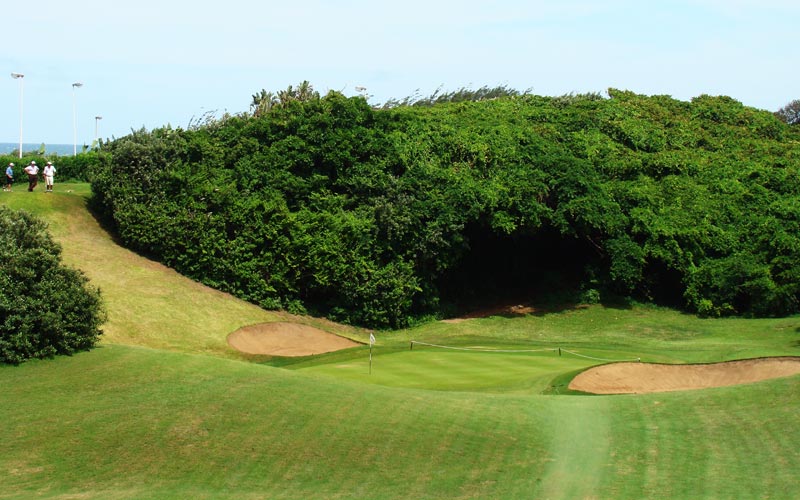
The dune in the foreground makes depth perception tricky as there is fifteen yards of dead space beyond it and where the fourth green commences.
Fifth hole, 460 yards; A brute of a hole, with the sight and sounds of the freeway hard on the golfer’s right and thick vegetation down the left. The fifth has become too narrow to be considered great and at one point the fairway artificially narrows to but twenty yards in width. This ends the demanding start and the sixth tee is at the far corner of the property closest to the ocean.
Seventh hole, 375 yards; Not unlike the tree problems that many Golden Age courses face in the United States, a case can be made that the vegetation is too smothering at Durban Country Club. First, it certainly is a penal hazard as it affords little opportunity to recover. Second, it robs the course of interesting playing angles and third, it diminishes the sense that the golfer would otherwise enjoy as to how unique the landscape is. However, in the case of the seventh, the vegetation is properly utilized, essentially out of play and acting to provide a handsome backdrop to the seventh green which is tucked in a little dell. Of the seven holes on the flatter property, this one has the most charm.
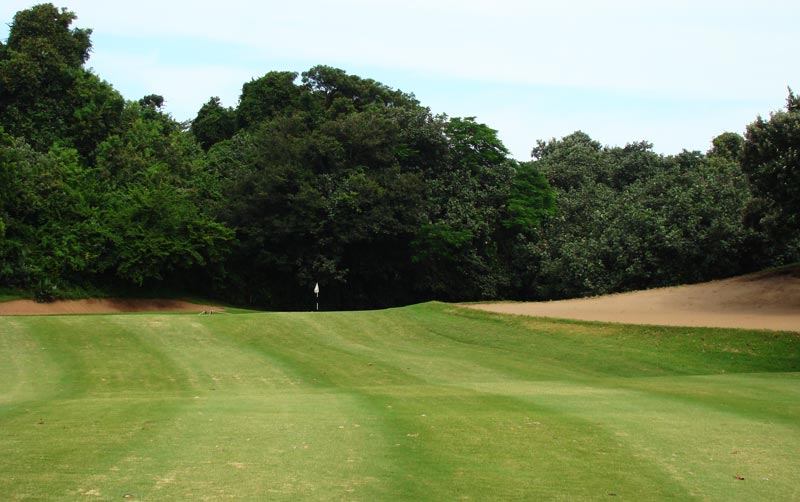
The seventh green is located in a pocket and is delightfully framed with coastal vegetation that is back from play.
Eighth hole, 505 yards; When Pat Ward-Thomas included the third on his list, he forever put Durban Country Club on the map as a must see course but he also stole attention away from what may well be an even better three shotter and that is this one just four holes later! While the third is closer to the ocean and its tee shot is more daunting , the eighth enjoys ground that is even more rousing and the second shot here holds far greater interest based on where the landforms fall. One thing is for certain: as the third and eighth are parallel but run in opposite directions, the two play wildly different on a typical breezy day.
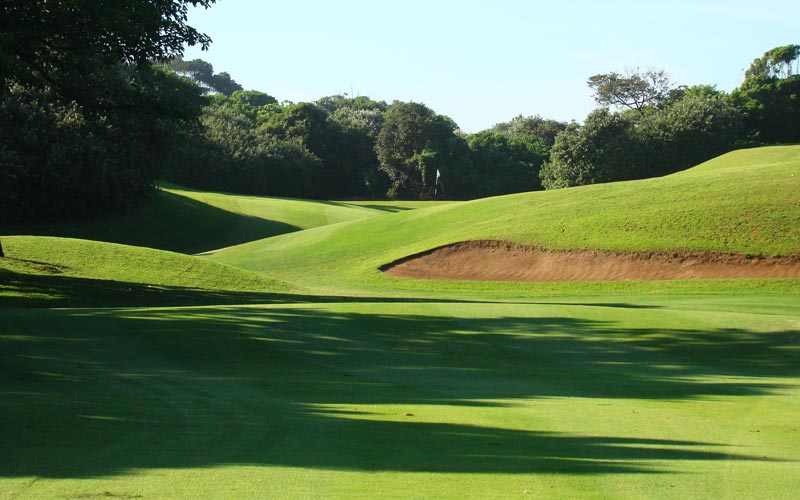
As seen from 220 yards out, does the golfer have what it takes to reach the elevated eighth green in two? If so, what a thrilling shot to pull off, possibly the best shot on the course.

For those that can’t reach the green, the pitch will be played in and among these tumbling landforms that only nature provides. Give the club full credit for not altering them over time. Two men on the green keeping staff have the experience and special skill sets to mow fairways like this one and the one at seventeen.
Durban Country Club
Natal, South Africa
Twelfth hole, 160 yards; This simple yet effective design of laying the tee and green along the spine of a dune has held the attention of golfers for nearly nine decades. Any tee ball pulled or pushed likely sends the golfer twenty feet below the putting surface, pitching uphill to a narrow target. The most famous incident involving this hole is also the one whereby it got its name, The Prince of Wales. During a morning round with Brews, the Prince of Wales, heir to the throne of George V, missed the green, watching as his tee ball tumbled down the steep bank. His recovery shot was a touch strong, going across the slender green and down the other bank. From there, his next shot not surprisingly wasn’t hit firm enough and the ball returned to his feet. Several more such attempts ensued and eventually a score was registered that was higher than the hole number, never a good thing for a back nine hole!

The sight of the flag laying limp is an unusual (but welcome one!) when playing the twelfth. Judging the wind is crucial as the drop-offs on either side are evident.
Seventeenth hole, 405 yards; A fabulous hole, the sort that drives professional golfers crazy, as there is no clear way to play it across the heaving landforms. A tee ball is bounced around like a pin ball and the resulting stance for one’s uphill approach is in the lap of the gods. Along the high right side of the fairway, there is more level terrain but the bush has been allowed to encroach too close and the risk/reward for seeking a level stance is out of whack at the moment. Nonetheless, this is the exact sort of hole that can only be found at Durban and it adds to one’s appreciation that nature always features prominently in creating the world’s most memorable holes.

For fairway contour, you can search the world and not find any as wild and random as that captured within the seventeenth fairway at Durban. Give the Golden Age architects plenty of credit for embracing these landforms within the hole.
Eighteenth hole, 275 yards; Teasing half par holes are the author’s favorite kind of Home hole. The Old Course at St. Andrews set the benchmark against which all others are judged and this is one of the few in the world that is comparable, right down to its own version of the Valley of Sin off the right front of the green. From the start, this finisher has produced great excitement at the best events held on the continent. One of the first times was the 1928 South African Open. Syd Brews was already in the clubhouse, having completed his four rounds in 298. His brother Jock dropped a shot at the tricky seventeenth when he failed to get up and down. Needing a birdie to tie, Jock playing the ground contours perfectly and his tee ball took the left to right slope to finish in the heart of the eighteenth green. In front of the masses that thronged the green, Jock holed his putt for an eagle two and a most dramatic victory.
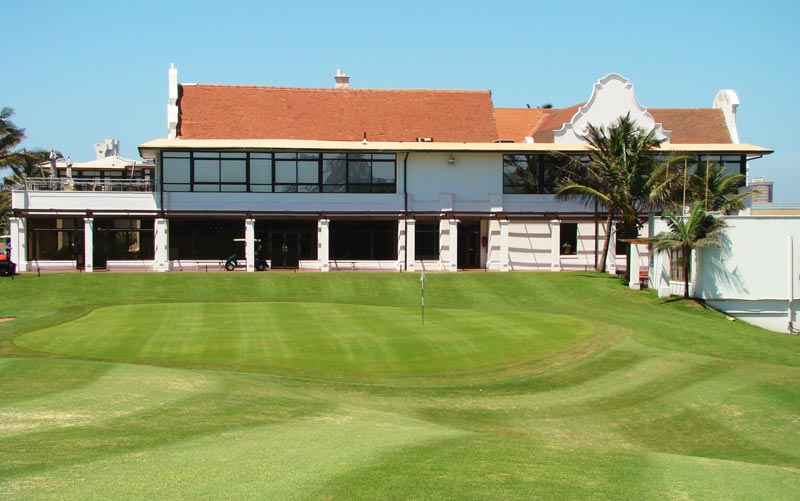
Located at the base of the clubhouse, the eighteenth green and its surrounds are full of character. Durban’s own version of the Valley of Sin snares either tee balls or approach shots that are a shade too weak and sends them well back into the fairway from where an up and down is no certainty.

Looking back down the eighteenth, this view captures how the hole was laid along the spine of the dune. A tee ball that fades down the left of the fairway will take the left to right fairway slope, bound past the depression at the front right and onto the green.
Durban’s one of a kind dunesland holes have stood it in good stead since its inception. Apart from when the panelists for GOLF Magazine mistakenly confused Royal Durban for Durban, this course has always appeared on the GOLF Magazine world top 100 list. However, as new courses are being built with some like Sand Hills in Nebraska and Ballyneal in Colorado featuring great natural land contour throughout, it is Durban’s flat holes that need attention. If they don’t hold their head up high, then it is just a matter of time before the course (sadly) drops from the world ranking. The club would do well to study the high level architecture at courses like Pacific Dunes and Friar’s Head whereby holes set on disparate land are seamlessly tied together, thus ensuring that the course enjoys a cohesive feel. Fortunately, there is not a lot of guess work required as to how the flatter holes should have character retuned to them – the aerial from the 1930s in the clubhouse shows the way forward. Simply restorting the tenth, fourteenth and fifteenth holes to how they played in the Golden Age would immeasurably help secure this design’s stature in world golf.

Here is a fine long bunker that snakes into the fourteenth fairway. However, ahead to the left is visible where other bunkers once were, swinging the fairway smartly to the right and working in tandem with the bunker above to lend interest to the second shot at the 520 yard fourteenth. These missing bunkers need to be restored.
Durban with its hustle and bustle, diverse culture and strong Indian influence is a fascinating city to visit. The game of golf needs to be represented by a world class course on the African continent. Considering that Durban features more true standout holes than Humewood, it is the logical candidate. Thus it is fervently hoped that the club takes steps to return character that has been lost with time to the holes that lie out from the dunes.
The End


